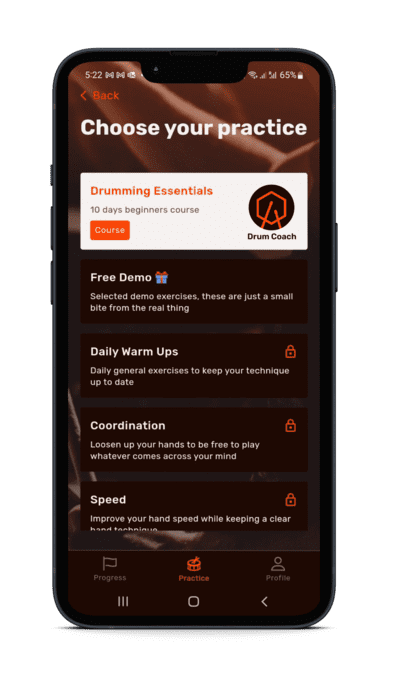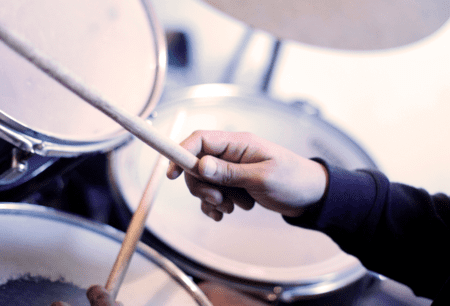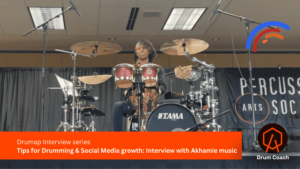Dream big, drum bigger! With Drum Coach, invest just 5 minutes daily for fun and effective practice that swiftly enhances your drumming. Begin your journey to greatness today!
Introduction
Hey groovers! Have you ever watched a drummer in full flow and wondered, “Are drums hard to learn?” If you’re thinking about picking up those sticks, you’ve landed in the right spot! Today, we’re diving into some of the most common questions aspiring drummers ask. Whether it’s about the difficulty, the time commitment, or the costs, we’re here to beat the drum on all these queries!
Here is the summary:
- How hard is it to learn drums?
- How long does it take to learn to play drums?
- Is playing the drums expensive?
- What do you need to start playing the drums?
- How to choose your perfect drumstick?
- How much space do I need to play drums?
- Do you need to learn how to read drum tabs?
- How to choose the best drum set?
How hard is it to learn drums?
Drumming can seem daunting at first. Unlike instruments where you can see the notes (like a piano or guitar), drumming is all about rhythm and feeling the music through physical motion. It’s about coordination and timing—skills anyone can develop with practice. So, are drums hard to learn? Yes and no. It’s challenging but incredibly rewarding and fun!
You may also find interesting 5 strategies to Learn Drums Effectively and How to Play the Drums with Confidence, From Beginner to Pro.
Get your drumming to the next level in just 10 days 🚀
Find your perfect practice routine with Drum Coach with exercises tailored for all levels. With Drum Coach you get:
- Drums lessons crafted by Mariano Steimberg, professional drummer, and professor at Berklee College of Music.
- Unlock over 500 drum exercises and rudiments
- Start Free with the Drumming Essentials course. No fancy gear needed!

How Long Does It Take to Learn to Play Drums?
The time it takes to learn drums varies. Some might bang out basic rhythms in a few weeks, while mastering more complex drumming techniques can take months or even years. It all depends on how often you practice. Regular practice sessions, even if they’re short, can accelerate your learning significantly.
We also recommend our post Essential Drumming Techniques for Beginners and The Key Drum Rudiments Every Drummer Must Know.
Are drums hard to learn? Let us answer this and other frequent questions about drumming.

Is Playing the Drums Expensive?
Starting with drumming doesn’t have to break the bank. Beginners can practice on affordable drum pads before investing in a full drum kit. However, if you decide to pursue drumming seriously, buying a quality drum set and possibly electronic equipment will involve some investment. Remember, you can always start small and upgrade as your skills and passion grow!
Dream of drumming like a pro?
Start free with our Drumming Essentials course. Go to your AppStore, download the Drum Coach app to get:
🥁 5 minutes of fun, daily exercises.
🎵 A beginner-friendly approach to improve steadily.
💡 Engaging lessons that make learning easy and effective.
You may also find interesting:
- Online Drum Lessons for Beginners, The Aspiring Drummer’s Roadmap
- Comparing the best apps to learn drums
What Do You Need to Start Playing the Drums?
To start, all you really need are drumsticks and a practice pad. This setup is perfect for learning basic rhythms and techniques without a large upfront cost. As you progress, you might consider a basic drum kit, which typically includes a snare drum, a bass drum, a couple of toms, and some cymbals.
How to Choose Your Perfect Drumstick?
Selecting the perfect drumstick hinges on understanding the code on each stick, which indicates its thickness and intended use. For instance, ‘A’ typically signifies lighter use, ideal for softer music, whereas ‘B’ suggests suitability for heavier playing. The number in the code indicates the stick’s thickness, with lower numbers like 2 or 5 denoting thicker sticks for vigorous playing styles, and higher numbers like 7 or 8 for thinner sticks ideal for gentler touches. Your choice should consider your musical genre, playing technique, and personal comfort. Thicker sticks are better for genres like rock or metal due to their durability, while lighter sticks are preferred for genres like jazz. It’s crucial to try different types and sizes to find what best complements your playing style and feels comfortable in your hand.
Want to rock drum rudiments? Join the Drumming Essentials course in Drum Coach app! With just 5 minutes daily, elevate your skills in 10 days. Fun, easy, and effective. 🚀✨
How Much Space Do I Need to Play Drums?
Drum kits, can be space-consuming. It’s important to allocate a specific area in your home where you can comfortably set up and play without spatial restrictions. A typical drum kit measures approximately 60 by 48 inches (152 cm by 122 cm), so plan your space accordingly. For those with limited room, an electronic drum kit is an excellent alternative. Not only do they require less space, but they also come with the added benefit of headphone compatibility, significantly reducing noise disturbances. This makes them ideal for apartment living or shared spaces.
Do You Need to Learn How to Read Drum Tabs?
While not required, reading music can be beneficial. Learning how to read drum tabs or drum notation isn’t as complex as it sounds, and learning it can help you understand rhythms and fills more quickly. Plus, it’s a great skill if you plan to play with other musicians or aspire to professional gigs.
Creating and sharing your drum notes has never been easier! With Drumap app you get:
- Extensive Groove library with over 150,000 rhythms.
- At Drumap, we’ve developed an incredibly user-friendly music creation tool.
- Wide array of instruments, from Drum set, Cajon, Rumba or Samba instruments, Congas, you name it, we are all about percussion.

How to Choose the Best Drum Set?
Choosing the right drum set involves balancing cost, quality, and personal musical needs, setting you up for a rewarding drumming experience. A standard beginner kit generally includes a bass drum, snare drum, toms, hi-hat, and cymbals, each offering distinct sounds that contribute to the overall versatility of the drum kit. Assessing whether to buy new or used is crucial; used sets can provide significant savings but require careful inspection for quality. The material of the drum shells, such as maple or birch, affects the sound quality, with maple providing a warm tone and birch offering a brighter sound. Additionally, ensure the hardware is sturdy and consider necessary accessories like drumsticks and a throne.
Final Thoughts: Should You Start Drumming?
Absolutely! Drumming is a thrilling, engaging activity that not only enhances your musical skills but also improves your coordination and cognitive abilities. It’s never too late to start, and the joy of creating music is a fantastic reward.
Aspiring to greatness on the drums? Let Drum Coach show you how, with only 5 minutes of fun, daily practice. Watch your drumming transform swiftly!
Get ready to take your drumming to the next level. Get expert tips on coordination, drumming techniques, improvisation and more in the post titled “Charting Your Drumming Journey”. / Written by: Raul Rodrigues: CEO of Drumap, Drummer, Music School Director and Mariano Steimberg: Drum Professor at Berklee College of Music, Valencia Campus.










